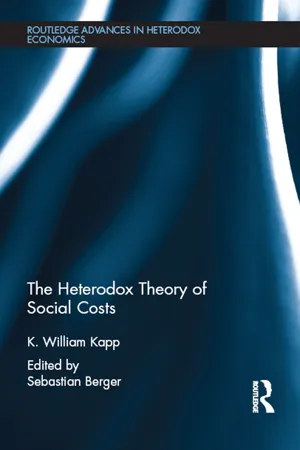Economics
Social Benefits
Social benefits refer to the positive impacts that an economic activity or policy has on society as a whole, beyond the direct benefits to the individuals or organizations involved. These can include improvements in public health, education, infrastructure, and overall quality of life. Social benefits are important considerations in evaluating the overall impact of economic decisions and policies.
Written by Perlego with AI-assistance
Related key terms
4 Key excerpts on "Social Benefits"
- eBook - ePub
- Neva Goodwin, Jonathan M. Harris, Julie A. Nelson, Pratistha Joshi Rajkarnikar, Brian Roach, Mariano Torras(Authors)
- 2018(Publication Date)
- Routledge(Publisher)
Chapter 1 ). A particular outcome may maximize social welfare in a quantitative sense but not necessarily be the best outcome from the perspective of social well-being.The goal of maximizing social welfare is sometimes viewed as a positive framework, which does not require normative judgments. In particular, it may seem that simply adding up all benefits and costs and choosing the option that yields the greatest net benefits avoids the potential biases of value judgments. But explicit and implicit value judgments are almost always involved in stating that a particular policy is “best.” For example, in a highly unequal society, would it be better to add $20 billion to the income of those who are already rich or $10 billion to the income of those who are currently poor? The former option offers the greatest net benefits in monetary terms, but the latter might be considered preferable on social and ethical grounds.Welfare economics considers the costs and benefits of three basic economic actors:- consumers
- producers
- the rest of society (including, for this discussion, future generations and the ecological context)
Consumers obtain benefits when they can voluntarily purchase a desired product at an acceptable price. Producers obtain benefits when they profitably sell products. But market transactions often result in costs or benefits to those not directly involved in the transaction, that is, the “rest of society.” For example, the production of paper can generate pollution that is harmful to the health of local residents. Such impacts on people not involved in the transaction were identified as externalities in Chapter 1 , also sometimes called third-party effects . In this chapter, we focus mainly on the costs and benefits to consumers and producers. However, we should be aware that any analysis that focuses exclusively on the consumers and producers involved in a market is likely to be incomplete. In Chapter 12 - eBook - ePub
- K. William Kapp, Sebastian Berger(Authors)
- 2015(Publication Date)
- Routledge(Publisher)
33There remains the important question of how the necessary consistency and interdependence of the various parts of the economic process can be established in harmony with social values and social development goals, particularly under dynamic conditions. With this question we cannot avoid reopening a discussion which has long been considered as closed and has all but disappeared from economic analysis: the problem of calculation in real terms. All experiences made during the last decades in connection with economic planning seem to support the conclusion of those who have argued that planning and the translation of social goals into an internally consistent development process call for a calculation in real terms rather than in terms of prices.This is relevant for our discussion. For social costs and Social Benefits are, to a large extent, extra-market phenomena. Hence the price system cannot be relied upon to provide the criteria for their social evaluation. Social costs as well as Social Benefits are heterogeneous in character, they cannot be evaluated in terms of a single denominator. As far as Social Benefits are concerned, the criteria available are social minima based upon a substantive and democratic evaluation of social needs and requirements and their comparison in real (physical) terms with available resources. What makes it possible and necessary to reopen this problem afresh are recent advances in our techniques and our knowledge concerning the quantitative input-output relationships between different industries. These studies have opened up new possibilities to express in quantitative terms the real costs of different social goals. Input-output balances provide the basis for a rational approach to the important task of coordinating output targets and input requirements throughout the economy. They yield the necessary data for the calculation of interdependencies and growth correlations between different sectors of the economy. Finally, knowledge of the physical inter-industry relationships answers important questions related to planning the capacity of supplementary investments called for by any large-scale multipurpose project. - eBook - ePub
- Craig Langston, Craig Langston(Authors)
- 2008(Publication Date)
- Routledge(Publisher)
9 Estimating social costs and benefits
DOI: 10.4324/9780080518251-99.1 Introduction
True social costs and benefits change the economic worth of society as a whole. Allocative efficiency is the key principle of cost-benefit analysis. Benefits are valued as the willingness to pay for utilities. Costs are valued as opportunity cost or the foregone return in its best alternative use. Sinden and Thampapillai (1995) use net social benefit to measure economic welfare by subtracting opportunity cost from willingness to pay. The analysis should include all changes in benefits/costs, externalities and unpriced outcomes. It should exclude sunk outcomes, fixed costs, transfer payments, double counting and international outcomes. It should consider taxes and subsidies, government charges, changes in asset values, and secondary benefits and costs. Social costs and benefits may be valued with market prices or without market prices.9.2 Valuation with market prices
Market price is the most commonly and satisfactorily used approach to value social costs and benefits generated by a project. When the market is competitive, market prices are used to measure the productivity change in terms of input and output (for marginal and non-marginal changes in quantity). Sinden and Thampapillai (1995 , p. 83) state that ‘a competitive market is characterised by the small market power of participants, mobility of outputs and inputs, unrestrained opportunities for response, homogeneity of goods, and complete knowledge’.Market demand is the basis of valuing benefits and market supply is the basis for valuing costs. Under marginal change in the production of a good, the benefit of an output (or the cost of an input) is its market price times the change in quantity. In the case of a non-marginal change in production, the benefit of an output is measured by the area below the demand curve and the cost of an input is measured by the area below the supply curve. - eBook - ePub
- Martin O'Donoghue(Author)
- 2017(Publication Date)
- Routledge(Publisher)
The real situation however, could be more complex than these remarks suggest since it would depend on other aspects of the economic environment. Thus, if a less educated but highly unionised segment of workers are able to secure wage increases for themselves, and the government operates a full employment policy which results in all of them being employed, then there will be a redistribution of income in their favour. This will have the effect of lowering the observed rate-of-return on education since it will narrow wage differentials among the more highly educated groups. The reverse possibility could also occur: Blaug, for example, refers to a study which suggests that some of the earning power of the U.S. medical profession may be the result of restrictive practices on their part and, if correct, this theory would overstate the value of their education from a community viewpoint. It seems possible then that different segments of the labour force are characterised by varying degrees of monopolistic power or other imperfections which lead to divergences between their earnings and the social value of their output. What is needed to resolve this issue is data for groups with varying amounts of education, in order to determine which groups are on balance the beneficiaries from market imperfections. In the absence of such data there is no way of deciding whether observed returns to each group are correct, whether they are an overstatement or an understatement.The existence of these imperfections may be noted, but it is not possible to say whether positive or negative correction is needed when seeking to calculate the social value of output, as distinct from the individual earnings associated with varying educational levels.The more difficult category of benefits to identify and measure are those which accrue, not to the individual, but to other members of the community. Such effects are usually termed ‘externalities’ or ‘neighbourhood’ effects, the object being to emphasise that individual behaviour affects other members of the society. Such ‘neighbourhood’ effects can affect either the production or consumption activities of others, and may be of a positive (benefits) or a negative (costs) nature. Many forms of economic activity have been suggested as giving rise to these effects and there is an extensive literature dealing with their economic implications and consequences.Education is considered as being one area which may give rise to several forms of ‘neighbourhood’ effect. By way of opening the discussion it may be convenient to adopt the framework used by Weisbrod, who in addition to his discussion of the various direct and indirect benefits to the individual, also presents a useful classification of externalities into residence-related benefits, employment-related benefits and benefits to the rest of society.An example of a residence-related benefit would be the child care service which a school provides in the case of younger children. This effect could take the form of a consumption benefit to mothers in that they might enjoy increased leisure time or reduced anxiety as a consequence of their children attending school. There could also be an economic benefit attached to the service, in that it may enable many mothers to work, who might otherwise find it uneconomic to pay for baby-sitting services during their absence at work.
Index pages curate the most relevant extracts from our library of academic textbooks. They’ve been created using an in-house natural language model (NLM), each adding context and meaning to key research topics.



